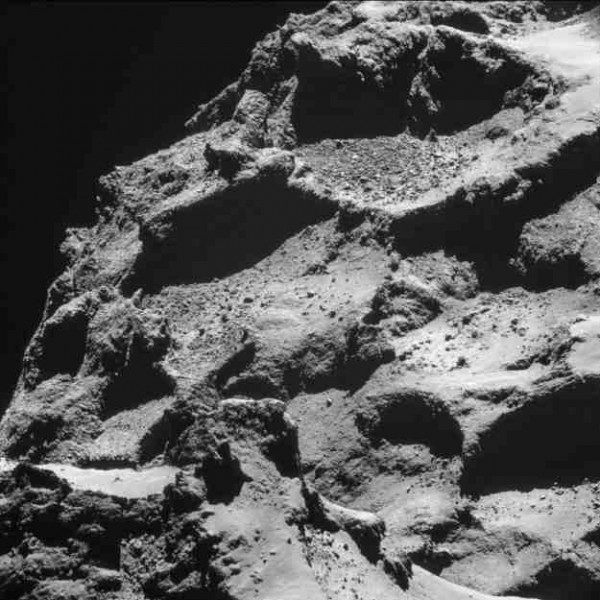Rosetta Releases Philae Lander for Touchdown; Thruster Failure Threatens Comet Landing
| Ana Verayo | | Nov 12, 2014 07:48 AM EST |
(Photo : ESA/Rosetta/NAVCAM) The smaller of Comet 67P/Churyumov–Gerasimenko’s two lobes (foreground in lower left) over to the larger lobe.
The European Space Agency's Rosetta probe's lander, Philae, is now descending towards Comet 67P Churyumov-Gerasimenko and will attach itself to the comet's surface to study its composition and terrain.
The Philae lander is a space lab of sorts the size of a washing machine. It separated from the Rosetta spacecraft at 8:35 GMT and confirmation reached the Earth at 9:05 GMT. It will take seven hours until Philae lands on Comet 67P. Touchdown is expected to occur at about 16:00 GMT.
Like Us on Facebook
This is the first time a spacecraft will attempt to land on a comet.
Rosetta flight operations director said Philae detached itself from Rosetta and is on a trajectory towards the comet's surface. Contact with Philae was lost following its separation from Rosetta. Contact will resume when Rosetta maneuvers into a favorable position at around 11:00 GMT.
From this point, data will be sent back to Earth for the first time. This data will include readings during Philae's grueling descent and telemetry that reports the status of the lander. After 13:00 GMT, photos and images from the descent will be beamed back to Rosetta that will then send the data to Earth.
According to Rosetta mission manager Fred Jansen, chances for the success of this mission stands at 75 percent. But overnight, the odds plunged as an important thruster failed to respond to Rosetta's commands.
This thruster failure threatened to abort the mission and engineers were unable to fix the glitch as Philae hurtled towards the comet. The thruster will fire nitrogen gas for 60 seconds to slow down Philae for a safe touchdown. The thruster is supposed to prevent Philae from bouncing off the comet while anchoring harpoons secure the lander to the icy surface.
Philae lander manager Stephan Ulamec said the problem will make the landing even more challenging since Philae will now have to rely only on its harpoons. The secondary anchoring system will be deployed as ice screws will be drilled into the surface.
The consistency of the surface is believed to be like compact snow and cigarette ash.
TagsRosetta Releases Philae Lander for Touchdown; Thruster Failure Threatens Comet Landing, ESA, rosetta, philae, comet 67P, rosetta releases philae comet landing 67P thruster failure
©2015 Chinatopix All rights reserved. Do not reproduce without permission
EDITOR'S PICKS
-

Did the Trump administration just announce plans for a trade war with ‘hostile’ China and Russia?
-

US Senate passes Taiwan travel bill slammed by China
-

As Yan Sihong’s family grieves, here are other Chinese students who went missing abroad. Some have never been found
-

Beijing blasts Western critics who ‘smear China’ with the term sharp power
-

China Envoy Seeks to Defuse Tensions With U.S. as a Trade War Brews
-

Singapore's Deputy PM Provides Bitcoin Vote of Confidence Amid China's Blanket Bans
-

China warns investors over risks in overseas virtual currency trading
-

Chinese government most trustworthy: survey
-

Kashima Antlers On Course For Back-To-Back Titles
MOST POPULAR
LATEST NEWS
Zhou Yongkang: China's Former Security Chief Sentenced to Life in Prison

China's former Chief of the Ministry of Public Security, Zhou Yongkang, has been given a life sentence after he was found guilty of abusing his office, bribery and deliberately ... Full Article
TRENDING STORY

China Pork Prices Expected to Stabilize As The Supplies Recover

Elephone P9000 Smartphone is now on Sale on Amazon India

There's a Big Chance Cliffhangers Won't Still Be Resolved When Grey's Anatomy Season 13 Returns

Supreme Court Ruled on Samsung vs Apple Dispute for Patent Infringement

Microsoft Surface Pro 5 Rumors and Release Date: What is the Latest?










